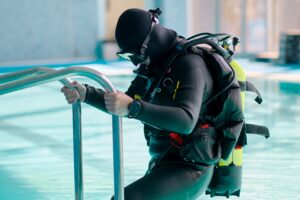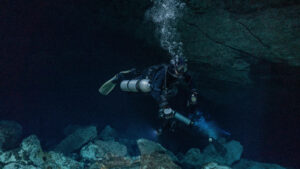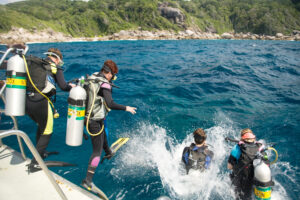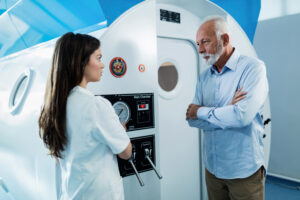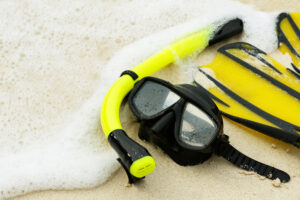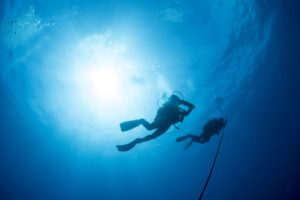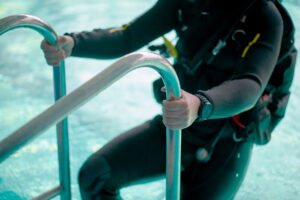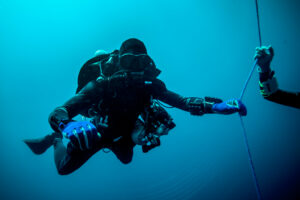Adjustable Buoyancy Life Jacket (ABLJ)
Overview
The Adjustable Buoyancy Life Jacket (ABLJ), an early form of buoyancy control device (BCD), played an instrumental role in the evolution of scuba diving. This pioneering innovation, serving as a buoyancy compensator and inflatable life jacket, was worn on the chest and around the neck. The ABLJ was designed with the dual purpose of aiding a diver’s buoyancy control underwater and providing an inflated life-saving vest on the surface.
Development and Design
The advent of the ABLJ revolutionized the safety and convenience aspects of scuba diving in the mid-20th century. It was primarily designed as a tool for managing a diver’s buoyancy— a critical aspect of diving safety and comfort. The ABLJ was typically constructed from durable and water-resistant material that could withstand the pressures and conditions of underwater environments.
The ABLJ consisted of a chest-mounted air bladder, which was connected to a round neck piece. A low-pressure inflator hose from the diver’s air tank supplied the bladder with air, allowing the diver to adjust buoyancy by inflating or deflating the bladder manually. In essence, the ABLJ operated as a ‘variable buoyancy vest’, granting the diver the ability to become neutrally buoyant at any depth.
Operation and Usage
The operation of an ABLJ was relatively simple. A diver could inflate the vest by using the low-pressure inflator to add air from the scuba tank or by exhaling into a mouthpiece on the vest. Conversely, the diver could deflate the vest by venting air through an exhaust valve, typically located on the shoulder or neck area of the ABLJ.
This provided a high degree of control and safety for the diver. When fully inflated on the surface, the ABLJ functioned as an effective life jacket, keeping the diver buoyant and their head above water. Underwater, the ABLJ allowed for precise buoyancy adjustments, enabling divers to maintain a specific depth or hover effortlessly in the water column.
Safety and Limitations
The ABLJ’s role as a life jacket significantly enhanced diver safety. It was particularly beneficial post-dive or during surface intervals when fatigue could set in, and additional buoyancy was needed. However, while the ABLJ was a leap forward in diving safety, it was not without its limitations.
One of the primary issues was the positioning of the buoyancy. As the ABLJ was worn around the chest and neck, inflation tended to force the diver into a ‘face-down’ position in the water, especially on the surface. This could be hazardous if the diver was unconscious or incapacitated.
Additionally, the design of the ABLJ did not offer any form of weight integration, a feature present in modern BCDs. Divers had to wear a separate weight belt to counteract the natural buoyancy of their bodies and diving equipment.
Evolution and Legacy
Despite its limitations, the ABLJ laid the groundwork for the buoyancy compensators used in modern scuba diving. The face-down flotation issue was eventually addressed with the development of the jacket-style and back-inflation BCDs, which distribute buoyancy more evenly around the diver.
The ABLJ’s role in promoting diving safety and enhancing buoyancy control cannot be overstated. Even though it has been largely superseded by more advanced designs, the ABLJ remains an important milestone in the history of scuba diving equipment. It stands as a testament to the continuous process of innovation and improvement that shapes the world of scuba diving, reminding us of our ongoing quest to explore the underwater world safely and effectively.
Conclusion
The Adjustable Buoyancy Life Jacket, with its dual functionality as a buoyancy compensator and life jacket, marked an important step in advancing diver safety and operational efficiency. Its design facilitated the nuanced control of buoyancy during dives and offered essential flotation support on the surface.
Impact on Training and Dive Practices
The ABLJ’s design and use significantly impacted scuba training and dive practices. It introduced the critical concept of active buoyancy control, necessitating new training methodologies and protocols. Divers needed to learn to manage their buoyancy by manipulating the inflator and deflator mechanisms on the ABLJ effectively. This not only improved the safety of dives but also enhanced divers’ overall experience by providing better control under water and comfort on the surface.
Technological Influence
The influence of the ABLJ extends beyond its direct application in scuba diving. Its design principles and operating mechanisms have influenced the development of other lifesaving and buoyancy devices. For instance, the principles of adjustable buoyancy have found applications in aviation and nautical safety equipment.
The ABLJ in Modern Diving
While the ABLJ has largely been replaced by more sophisticated BCD designs in modern recreational diving, it is still used in certain niches of the diving world. Some vintage diving enthusiasts prefer using an ABLJ due to its historical significance and unique operating experience.
Furthermore, despite the evolution of BCD technology, the fundamental principles of buoyancy control first implemented in the ABLJ remain a critical part of diver education and training. The skills developed while using an ABLJ are still applicable to and highly valued in the use of modern BCDs.
Final Remarks
The Adjustable Buoyancy Life Jacket stands as a significant milestone in the history of diving equipment. As a pioneering piece of technology, it bridged the gap between the rudimentary systems of the past and the advanced, integrated buoyancy systems of today. Although its use in modern diving has diminished, its impact on diving safety, technology, and education continues to resonate throughout the industry.


